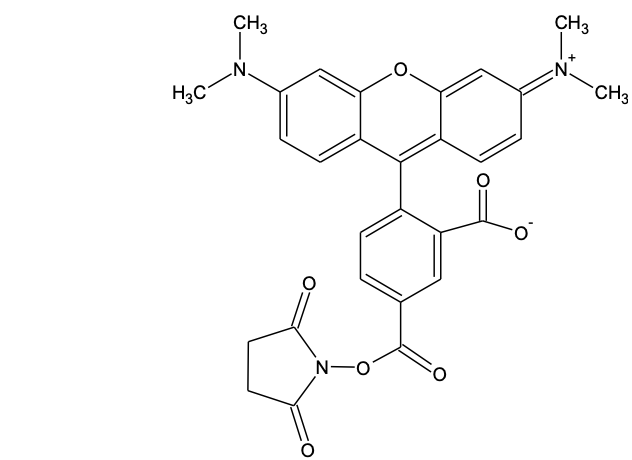Fluorescent Dye Carboxylic Acids and Their Succinimidyl Esters
Succinimidyl esters are proven to be the best reagents for amine modifications because the amide bonds that are formed are essentially identical to, and as stable as the natural peptide bonds. These reagents are generally stable and show good reactivity and selectivity with aliphatic amines. There are few factors that need be considered when SE compounds are used for conjugation reaction:
1). Solvents:For the most part, reactive dyes are hydrophobic molecules and should be dissolved in anhydrous dimethylformamide (DMF) or dimethylsulfoxide (DMSO).
2). Reaction pH:The labeling reactions of amines with succinimidyl esters are strongly pH dependent. Amine-reactive reagents react with non-protonated aliphatic amine groups, including the terminal amines of proteins and the e-amino groups of lysines. Thus amine acylation reactions are usually carried out above pH 7.5. Protein modifications by succinimidyl esters can typically be done at pH 7.5-8.5, whereas isothiocyanates may require a pH 9.0-10.0 for optimal conjugations.
3).Reaction Buffers:Buffers that contain free amines such as Tris and glycine and thiol compounds must be avoided when using an amine-reactive reagent. Ammonium salts (such as ammonium sulfate and ammonium acetate) that are widely used for protein precipitation must also be removed (such as viadinlysis) before performing dye conjugations.
4). Reaction Temperature:Most conjugations are done at room temperature. However, either elevated or reduced temperature may be required for a particular labeling reaction.
5-TAMRA, SE [5-Carboxytetramethylrhodamine, succinimidyl ester]
| Features and Biological Applications5-TAMRA, SE is predominantly used for labeling peptides and proteins while 6-TAMRA, SE is often used for labeling nucleotides and sequencing nucleic acids. The single TAMRA isomers are increasingly preferred for labeling peptides and nucleotides because they give better resolution in HPLC purification that is often required in the conjugation processes. |
References
1. Evans NA, et al. (2001). Visualizing differences in ligand-induced beta-arrestin-GFP interactions and trafficking between three recently characterized G protein-coupled receptors. J Neurochem77, 476-85.
2. Nasarabadi S, et al.(1999). Simultaneous detection of TaqMan probes containing FAM and TAMRA reporter fluorophores. Biotechniques27, 1116-8.
NOTE: Always wear lab coats, gloves and goggles when working with our products although they are low-risk chemicals for R&D only.
| Name | 5-TAMRA, SE [5-Carboxytetramethylrhodamine, succinimidyl ester] *Single isomer* | ||
|---|---|---|---|
| CAT# | 373-100 mg;373-1g | CAS# | 150810-68-7 |
| Storage# | −20°C and desiccated | Shelf Life# | 12 months |
| Ex(nm)# | 547 | Em(nm)# | 575 |
| MW# | 527.53 | Solvent# | DMF or DMSO |
| Name | 5-TAMRA, SE [5-Carboxytetramethylrhodamine, succinimidyl ester] *Single isomer* |
|---|---|
| CAT# | 373-100 mg;373-1g |
| CAS# | 150810-68-7 |
| Storage# | −20°C and desiccated |
| Shelf Life# | 12 months |
| Ex(nm)# | 547 |
| Em(nm)# | 575 |
| MW# | 527.53 |
| Solvent# | DMF or DMSO |


![5-TAMRA, SE [5-Carboxytetramethylrhodamine, succinimidyl ester] *Single isomer* 详细说明书](/en/Public/Home/images/pic52.png) Specification
Specification![5-TAMRA, SE [5-Carboxytetramethylrhodamine, succinimidyl ester] *Single isomer* 技术资料](/en/Public/Home/images/pic53.png) Support
Support




